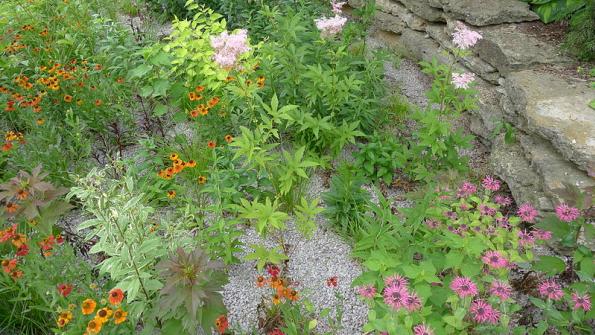Municipalities turn to rain gardens as ways to manage stormwater, beautify areas
Cities and counties have found success in using rain gardens as a means of effective stormwater management while simultaneously beautifying their communities through the additional green space these gardens create.
A rain garden is a landscaped basin filled with plants that holds stormwater instead of letting it become runoff, according to a Fairfax County, Va. materials. The held stormwater slowly returns to the soil, which removes pollutants and becomes available to plants. Rain gardens help prevent contaminated runoff from entering nearby bodies of water while providing additional green space.
Wilmington, N.C. is partnering with North Carolina State University and non-profit organization DREAMS to build a rain garden in a parking lot, according to local TV station WECT. Part of the parking lot around the rain garden will be paved with a material that has openings and allows potentially polluted rainwater to soak into the ground, rather than flow into a nearby creek.
The Greater Kokomo, Ind. Downtown Association, Howard County Master Gardeners Association, Howard County Commissioners, and Howard County Stormwater District recently celebrated the opening of Kokomo’s Rain Garden Plaza, which is the city’s first stormwater management model site, The Kokomo Perspective reports. The project includes several rain gardens and porous paving; unlike many rain gardens, the plaza will include lights, benches and a stage area to accommodate performances.
The Franklin County, Mass. Department of Public Works recently sponsored a tour with the Charles River Watershed Association (CRWA) to show its residents the advantages of using rain gardens to manage stormwater, according to the Milford Daily News. In total, the county has 15 rain gardens and 94 rainwater holding basins installed throughout its land. The county’s DPW and volunteers maintain the county’s rain gardens.
"Franklin tries to incorporate a stormwater asset in every roadway project,” Franklin DPW Director Brutus Cantoreggi told the Daily News. “We like incorporating rain gardens because they're cost effective and have high visibility. They are a great way to educate residents about the benefits of managing stormwater.”
The rain gardens were created in partnership with the CRWA in a project called the Blue Cities Initiative, the Daily News reports. The initiative seeks to use green infrastructure to solve stormwater issues and beautify neighborhoods.
In January, Columbus, Ohio announced plans to install 400-500 rain gardens in its Clintonville area in order to combat stormwater runoff, according to the Columbus Dispatch. But not everyone is happy about the decision. Residents have raised concerns about the city using their lawns to install the gardens, while others expressed concern about children getting hurt or even drowning were they to fall into it.
Nevertheless, the Dispatch reports that officials expressed satisfaction at citizen response. “I think people in the Clintonville area are generally pleased with the idea of rain gardens rather than the cost and inconveniences (of) tearing up all the roads to replace the storm-sewer system,” Clintonville Area Commission Chairman Kristopher Keller told the Dispatch.
Per the plan, the size of the rain gardens will vary widely, the gardens will be weeded and pruned, and they will contain a variety of flowers, the Dispatch reports. The work is set to start this year.
_____________
To get connected and stay up-to-date with similar content from American City & County:
Like us on Facebook
Follow us on Twitter
Watch us on YouTube




















